
Puerto Rican cuisine consists of the cooking style and traditional dishes original to Puerto Rico. It has been primarily influenced by the ancestors of the Puerto Rican people: the indigenous Taínos, Spanish colonizers, and sub-Saharan African slaves. As a territory of the U.S., the culinary scene of Puerto Rico has also been moderately influenced by American cuisine.
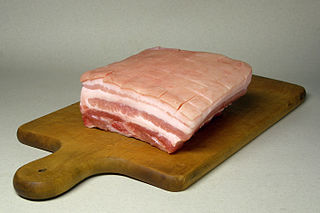
Pork belly or belly pork is a boneless and fatty cut of meat from the belly of a pig. Pork belly is particularly popular in Filipino, Hispanic, Chinese, Danish, Norwegian, Korean, and Thai cuisine.
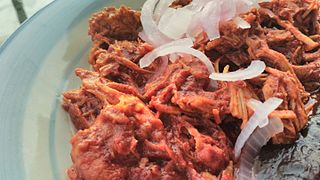
Cochinita pibil is a traditional Yucatec Mayan slow-roasted pork dish from the Yucatán Peninsula. Preparation of traditional cochinita involves marinating the meat in strongly acidic citrus juice, adding annatto seed, which imparts a vivid burnt orange color, and roasting the meat in a píib while it is wrapped in banana leaf.

Chicharrón is a dish generally consisting of fried pork belly or fried pork rinds. Chicharrón may also be made from chicken, mutton or beef.

Pork ribs are a cut of pork popular in Western and Asian cuisines. The ribcage of a domestic pig, meat and bones together, is cut into usable pieces, prepared by smoking, grilling, or baking – usually with a sauce, often barbecue – and then served.

Siu mei is the generic Cantonese name of meats roasted on spits over an open fire or a large wood-burning rotisserie oven. It creates a unique, deep barbecue flavor and the roast is usually coated with a flavorful sauce before roasting. Siu mei is very popular in Hong Kong and Macau, and overseas Chinatowns especially with Cantonese emigrants. In Hong Kong, the average person eats siu mei once every four days, with char siu being the most popular, followed by siu yuk in second, and roast goose being third. Some siu mei such as white cut chicken and soy sauce chicken are not roasted at all but they are still considered siu mei nonetheless. siu mei is also known colloquially as siu laap, as the latter term encompasses siu mei and laap mei, a type of preserved meat. They are usually prepared in the same kitchen during autumn and winter season in what are often known as siu laap establishments or Chinese BBQ shops. Siu laap is also often sold alongside lou mei, such as orange cuttlefish and Pig's ear.

Schweinshaxe (German pronunciation:[ˈʃvaɪns.haksə] ), in German cuisine, is a roasted ham hock (or pork knuckle). The ham hock is the end of the pig's leg, just above the ankle and below the meaty ham portion. It is especially popular in Bavaria as Schweinshaxn [ˈʃvaɪns.haksn̩] or Sauhax(n) [ˈsaohaks(n̩)]. A variation of this dish is known in parts of Germany as Eisbein, in which the ham hock is pickled and usually slightly boiled.

Cuchifritos or cochifritos refers to various fried foods prepared principally of pork in Spanish and Puerto Rican cuisine. In Spain, cuchifritos are a typical dish from Segovia in Castile. The dish consists of pork meat fried in olive oil and garlic and served hot. In Puerto Rico they include a variety of dishes including morcilla, papas rellenas, and chicharron, and other parts of the pig prepared in different ways. Some cuchifritos dishes are prepared using plantain as a primary ingredient. Cuchifritos vendors also typically serve juices and drinks such as passionfruit, pineapple, and coconut juice, as well as ajonjolí, a drink made from sesame seeds.

Spare ribs are a variety of ribs cut from the lower portion of a pig, specifically the belly and breastbone, behind the shoulder, and include 11 to 13 long bones. Meat and fat cover the bones. Spare ribs (pork) are distinguished from short ribs, which are beef. Spareribs are typically cooked low and slow, either smoked, grilled, or braised.

Dominican cuisine is made up of Spanish, indigenous Taíno, Middle Eastern and African influences. The most recent influences in Dominican cuisine are from the British West Indies and China.
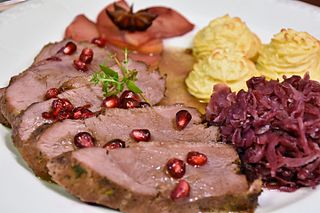
Roast goose is cooking goose meat using dry heat with hot air enveloping it evenly on all sides. Many varieties of roast goose appear in cuisines around the world, including Cantonese, European, and Middle Eastern cuisines. Roasting can enhance its flavor.
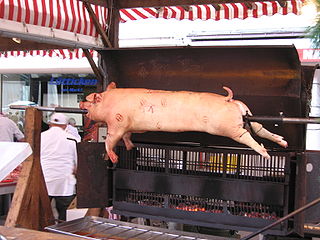
A pig roast or hog roast is an event or gathering which involves the barbecuing of a whole pig.

Souvla is a popular dish from Cyprus. It consists of large pieces of meat cooked on a long skewer over a charcoal barbecue.

The cuts of pork are the different parts of the pig which are consumed as food by humans. The terminology and extent of each cut varies from country to country. There are between four and six primal cuts, which are the large parts in which the pig is first cut: the shoulder, loin, belly and leg. These are often sold wholesale, as are other parts of the pig with less meat, such as the head, feet and tail. Retail cuts are the specific cuts which are used to obtain different kinds of meat, such as tenderloin and ham. There are at least 25 Iberian pork cuts, including jamón.

Arroz con gandules is a combination of rice, pigeon peas, and pork, cooked in the same pot with sofrito. This is Puerto Rico's national dish along with roasted pork.

Hamonado, or hamonada, is a Filipino dish consisting of meat marinated and cooked in a sweet pineapple sauce. It is a popular dish during Christmas in Philippine regions where pineapples are commonly grown. Hamonado is also a general term for savory dishes marinated or cooked with pineapple in the Philippines.

Pork rind is the culinary term for the skin of a pig. It can be used in many different ways.
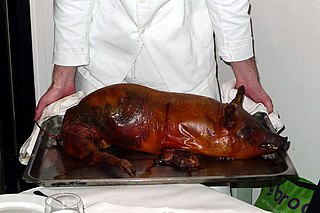
A suckling pig is a piglet fed on its mother's milk. In culinary contexts, a suckling pig is slaughtered between the ages of two and six weeks. It is traditionally cooked whole, often roasted, in various cuisines. It is usually prepared for special occasions and gatherings. The most popular preparation can be found in Spain and Portugal under the name lechón (Spanish) or leitão (Portuguese).


















